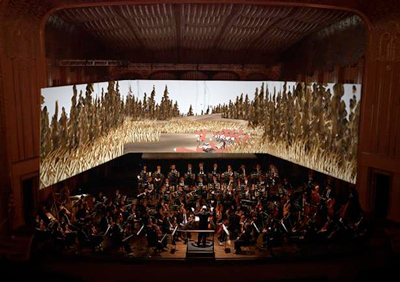by Mike Telin
Opera librettists take their inspiration from novels, novellas, plays and legends, but rarely from a daily comic strip. “The Adventures of the Vixen Sharp-Ears,” a serialized cartoon by Rudolf Těsnohlídek and Stanislav Lolek in the Czech newspaper Lidové novini gave Leoš Janáček the idea for his comic opera, The Cunning Little Vixen, for which he wrote the libretto himself.
Is it a children’s entertainment? The characters include animals, birds and insects, as well as a few human beings, but Janáček himself seems to have intended it to be a philosophical reflection about the cycle of life and death. The plot is open to a whole spectrum of interpretation, “but I can tell you that this production will appeal to the widest public components possible,” said tenor David Cangelosi, who sings the roles of the Schoolmaster and the Mosquito. “It just has something for everybody – the littlest of kids straight through to the most seasoned opera or symphony goer.”
The Cunning Little Vixen, a made-for-Cleveland production designed specifically for Severance Hall and directed by Yuval Sharon, will feature animations by Bill Barminsky and Christopher Louie of Walter Robot Studios, projected on three giant screens. The opera will be performed on May 17, 20 and 22 at 8:00 pm and May 24 at 2:00 pm. The 90-minute production involves a large cast of singers, with The Cleveland Orchestra, Cleveland Orchestra Chorus and Children’s Chorus conducted by Franz Welser-Möst.
David Cangelosi feels this production is the most innovative multi-media integration he has ever been involved with. He points out that many companies including the Metropolitan Opera and San Francisco Opera have incorporated projections into productions, “but this is the first time we’ve been asked to sing with our heads through a porthole and have bodies projected onto us,” he said with a laugh during a recent telephone conversation. “So we are integrated into the projections, not just having them behind us. It’s been hilariously fun because we’re being told what to do and which direction to look, while having no idea what our bodies look like, although we were able to see the animations early on during production presentations, so we do have some idea.”
Another feature of the production Cangelosi finds fun is the use of masks. “These masks that have been created for us by Cristina Waltz are incredible. I must say there’s been a lot of laughter during rehearsals as we try to get the portholes open and our heads through them. I’m a mosquito and the mask has this gigantic stinger for a nose. So until I became used to it, I was bumping into everything backstage. It’s been really funny.”
Throughout the conversation Cangelosi speaks about the fun he and he fellow cast members are having. He attributes that to the director, Yuval Sharon, who is constantly in a good mood. “He laughs a lot and you can’t help but laugh with him. He enjoys a good joke — both telling one and receiving one. And if we struggled a little bit early on, it wasn’t the kind of intense struggle that leads to frustration. It’s been a struggle that has evoked laughter.”
When first approached about the project, Cangelosi had only a vague idea about the form the production would take. “The earliest reports were that it was going to be a semi-staged Cunning Little Vixen.” As time passed, it became clear that this was going to be one of the most innovative productions ever — a fully-staged opera with animated accoutrements.
“Fully-staged” had its own innovative twists. “At first we thought, great, all the audience will see is our faces, so we don’t have to learn any staging,” Cangelosi said. “This is going to be really easy. Then we discovered that the portholes were on different levels so we would have to climb different staircases backstage. Then we realized that we would only be animated as animals. When we are in our human incarnations we are going to be onstage in costume complete with wigs.”
The innovations continue with the location of the instrumentalists. “The orchestra will be seated on three different levels using pit formation. Maestro will be on the lowest level with a good portion of the orchestra a short level up, with another portion on the next level. Then you have the stage level — I call it a tiered display. I think that as soon as they enter the hall, even before a note is played, people are going to realize that they are about to see something completely different.”
Cunning Little Vixen incorporates both an international and local cast. “Everyone from top to bottom is as first rate as any I have worked with at any opera house anywhere,” Cangelosi, himself a Parma native, said. “We hope the audiences love it as much as we have had fun preparing it. Because that is exactly what it has been, a great joy.”
Published on ClevelandClassical.com May 13, 2014.
Click here for a printable copy of this article.





